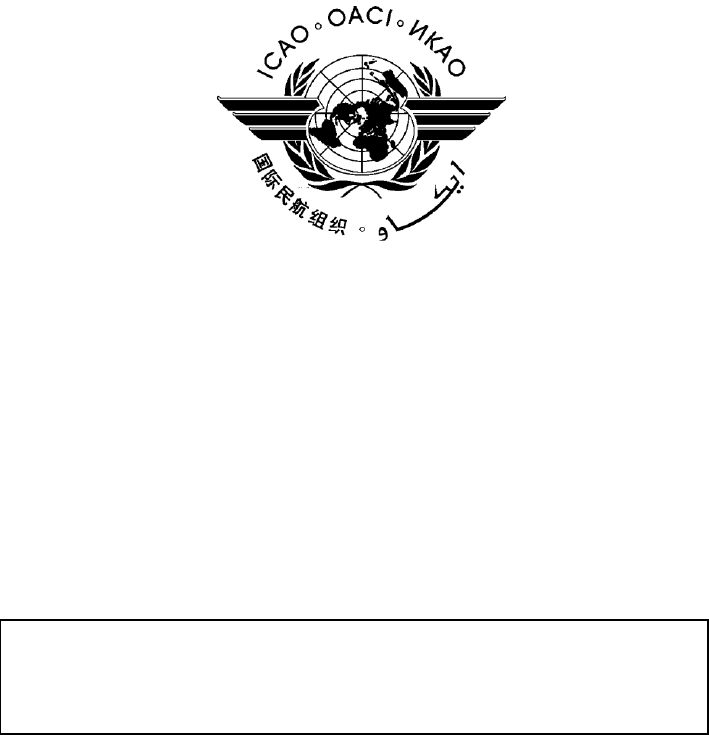
INTERNATIONAL CIVIL AVIATION ORGANIZATION
ASIA/PACIFIC REGIONAL
AIR TRAFFIC FLOW MANAGEMENT
CONCEPT OF OPERATIONS
Version 1.0 September 2015
This document was developed by the Asia/Pacific Air Traffic Flow
Management Steering Group (ATFM/SG)
Approved by APANPIRG/26 and published by the
ICAO Asia and Pacific Office, Bangkok
Asia/Pacific Regional ATFM Concept of Operations
Table of Contents
1. Overview ............................................................................................................................ 3
2. Scope .................................................................................................................................. 3
3. Current Operations in the Asia/Pacific Region .................................................................. 3
4. Concept – Regional ATFM ................................................................................................ 5
5. Operational Scenario ........................................................................................................ 23
6. Expected Benefits of the Concept .................................................................................... 26
Attachment A: ATFM Background .......................................................................................... 1
Attachment B: Participation Analysis – Changi Case Study .................................................... 1

Asia/Pacific Regional ATFM Concept of Operations
1. Overview
Concept Development
1.1 This Asia/Pacific Regional Air Traffic Flow Management (ATFM) Concept of
Operations, hereinafter referred to as the CONOPS, was initially developed under a collaborative
effort involving the Civil Aviation Authority of Singapore and research and industry partners, and
further developed through expansion of the stakeholder group to include other ANSPs (AEROTHAI,
Department of Civil Aviation Malaysia, Hong Kong Civil Aviation Department), IATA and major
airlines.
1.2 The Concept was tested in a series of Human-in-the-Loop (HITL) simulation
exercises held at the Singapore Aviation Academy. It is based upon operationally proven ATFM
Measures or Traffic Management Initiatives (TMIs), used to more efficiently manage delays incurred
by all aircraft arriving at a constrained resource, such as an airport or a sector of airspace, regardless
of their point of departure and including flights controlled by ANSPs outside the control authority of
ATC at the constrained resource.
Fundamental Concept of ATFM
1.3 Central to this CONOPS is the fundamental concept of balancing air traffic demand
and capacity. While ANSPs and airport operators should strive to increase and optimize airspace and
airport capacity to meet demand, traffic growth, surges in traffic and capacity constraining events
cause imbalances. TMIs that may be utilized include inter-alia strategic landing slot allocation,
miles/minutes in trail, level capping, re-routing and tactical airport slot allocation.
1.4 Implementation of effective ATFM improves predictability, reduces fuel burn and
operating costs, reduces pilot and ATC workload, and improves and maintains safety.
ATFM and Collaborative Decision-Making
1.5 The Collaborative Decision Making (CDM) process, a key enabler of ATFM, allows
all of its subscribing members, called CDM stakeholders, to participate in decisions that affect them
after all relevant information has been made available to them. This applies to all types of decisions in
the strategic, pre-tactical, and tactical phases.
1.6 Figure 1 illustrates the integration of CDM into ATFM functions. The flow shows
the independent evaluation of capacity and demand for the resource, the monitoring of the demand
and capacity, the evaluation of TMIs, the involvement of stakeholders through CDM, and the
execution and updating of the TMI. Core functions of shared situational awareness and post-
operations analysis are supported across all functions.

Asia/Pacific Regional ATFM Concept of Operations
1.7 Using the available data, demand and capacity are monitored throughout the day with
close communication with other resource managers to identify any imbalances. Flow Managers have
tools in order to evaluate various TMIs before implementation. Once a TMI is implemented, Aircraft
Operators perform CDM actions, such as substitutions, to optimize their operations while the Flow
Manager monitors the effectiveness of the TMI.
Figure 1: ATFM/CDM Functions

Asia/Pacific Regional ATFM Concept of Operations
2. Scope
2.1 This document presents the Asia/Pacific Regional ATFM Concept, supporting
demand and capacity balancing for airports and airspace within the Asia/Pacific Region. The Concept
includes existing ATFM/CDM principles, and a new Traffic Management Initiative (TMI) concept
that complements conventional Ground Delay Programs (GDPs). Collaborative Decision-Making
2.2 (CDM) is a key component of the Concept and is covered throughout the document.
The Concept may be applied to any airport or airspace within the Asia Pacific region or elsewhere,
especially in those airports or airspace servicing significant numbers of international flights.
Document Overview
2.3 The document first discusses current operations, providing the justification for the
Regional ATFM Concept. The proposed concept is then provided, followed by an operational
scenario illustrating the concept, and finally the expected benefits.
2.4 The concept will affect each stakeholder differently. The specific roles of each
stakeholder group are detailed; Flow Management Position (FMP), Aircraft Operators, Airport
Operators, the ATC Tower, and the ATC Area Control Center roles are explained in Section 4.
The document has the following Sections:
Section 3 - Current Operations, describes the current state of ATFM
operations in Asia Pacific and the associated need for improvement.
Section 4 - Proposed Concept – Regional ATFM, provides a detailed
description of the concept, including assumptions, core capabilities, stakeholder
responsibilities, and policy considerations. The section first describes the parts
of the concept that must be consistent for any implementation of Regional
ATFM. Implementation considerations, adaptable according to the needs of
individual ANSPs are also described.
Section 5 - Operational Scenario, illustrates an example of the step-by-step
procedures for handling a given capacity reducing event, following the Regional
ATFM Concept.
Section 6 - Expected Benefits of Proposed Concept, presents a summary of
the expected benefits resulting from the implementation of the proposed
concept.
3. Current Operations in the Asia/Pacific Region
3.1 ANSPs in the Asia/Pacific region currently have limited ATFM/CDM procedures in
place to manage the traffic flows within their areas of responsibility. There are also very few regional
agreements to manage traffic flows between ANSPs. Asia/Pacific stakeholders do have some tools
and processes to monitor and predict resource utilization, but the predictions are not always accurate,
automated, or shared among regional stakeholders.

Asia/Pacific Regional ATFM Concept of Operations
3.2 Strategic balancing of capacity at airports in the region is currently undertaken
through the airport slot allocation process. During the pre-tactical and tactical ATFM phases
1
,
balancing of arrival demand with the available capacity at airports is mostly reactive in nature.
Planning TMIs ahead of time is difficult because the demand data are not generally accurately
predicted and there is limited control of departures. As a result, most of the demand balancing is
carried out by ANSPs within their own area of responsibility through tactical flow management with
the support of arrival management systems (AMAN). This reactive management of demand often
results in inefficient means of balancing flows, such as airborne holding and vectoring.
3.3 A challenge in terms of implementing more advanced ATFM systems within the
region is the high percentage of international traffic. This characteristic poses a challenge to
implementation because initiatives such as Ground Delay Programs (GDPs) assign flights Calculated
Take Off Times (CTOTs) with which they must comply. In current ATFM implementations, flights
departing from airports outside of the ANSP’s controlling authority operate as they originally
intended, without absorbing all of the delay. Because of the unique characteristics of the Asia Pacific
region a new cross-FIR boundary concept is proposed to overcome this challenge and effectively
apply ATFM measures to flights operating into constrained airports and airspace, while operating
from airports or in the airspace of a different control authority.
3.4 There are, however, several ANSPs in the region with significant domestic traffic,
such as in Australia and Japan, where GDPs are effective with only domestic traffic operating in
accordance with assigned slots. International collaboration for demand and capacity balancing has
been demonstrated by such initiatives as the Bay of Bengal Cooperative Air Traffic Flow
Management System (BOBCAT).
Bay of Bengal Cooperative Air Traffic Flow Management System (BOBCAT)
3.5 BOBCAT is a secure web-based computer system used to manage westbound aircraft
operating through Afghanistan airspace from South and Southeast Asia to Europe during the busy
nighttime period.
3.6 As a result of the lack of Communication Navigation Surveillance (CNS) facilities
and military operations aircraft flying through this airspace are subject to restrictive separation
requirements. In 2006 ICAO, upon request of IATA, formed a task force to implement a solution to
the restrictions placed on aircraft flying through Afghanistan airspace. AEROTHAI consequently
developed a web-based solution which was implemented in July 2007.
3.7 BOBCAT assigns take-off times (departure slots) and levels for flights crossing the
Kabul FIR based on Aircraft Operator requests. The request period is specified and the slot allocation
occurs based on the existing requests. Aircraft Operators can request adjustments to the slot
allocations based on their operational need and availability.
3.8 Some of the benefits realized since implementation of BOBCAT are:
Regularity of departures
Orderly Afghanistan entry
Optimal FL achieved (80 – 90% in Afghanistan)
Reroutes and technical stops eliminated
Reduction of Air Traffic Control Officer and flight crew workloads
1
Strategic, Pre-Tactical and Tactical ATFM Phases are defined in ICAO Doc 9971 – Manual on Collaborative
Air Traffic Flow Management

Asia/Pacific Regional ATFM Concept of Operations
Environmental Outcomes (Annual, based on IATA estimates in 2007):
- Estimated Airline Cost Savings: US$86 million
- Estimated Fuel Savings: 85,000 metric tonnes
- Estimated Emissions Savings: 356,000 metric tonnes
ATFM in Australia
3.9 Airservices Australia has an automated ATFM system where projected demand and
capacity are balanced through the implementation of TMIs, predominantly GDPs, and the assignment
of ATFM slot times to aircraft. Aircraft Operators are advised of flight-specific off-block times at the
domestic departure airports. These off-block times are calculated to deliver aircraft to the destination
airport at the allocated arrival slot time. The ATFM system is used for pre-tactical and tactical
planning and managing the arrival flows associated with the major Australian airports of Sydney,
Melbourne, Brisbane, and Perth. The system offers effective pre-tactical and tactical decision support
for managing demand-capacity imbalances and reducing air traffic saturation. CDM is supported
through flight schedule updates, shared situational awareness, and schedule management (e.g.,
substitutions and cancellations).
ATFM in Japan
3.10 In 2005 the Japanese Civil Aviation Bureau (JCAB) established the Air Traffic
Management Center (ATMC) by recomposing the existing ATFM Center to act as the leading and
central function in order to drive forward Japanese Air Traffic Management (ATM). Through this
office they are developing and implementing typical ATFM measures such as GDPs with slot
swapping capability, re-routing, miles/minutes in trail, and Specifying Calculated Fix Departure Time
for Arrival Spacing Program (SCAS). The ATMC has implemented CDM practices through twice
yearly stakeholder meetings and making available dynamic capacity changes every hour using web-
based information sharing.
4. Concept – Regional ATFM
4.1 The regional concept was developed specifically for ANSPs in the Asia Pacific
region, but could also be implemented in other regions. The Asia/Pacific region is comprised of
independent ANSPs, each with ATM authority for their respective FIR and no overarching authority
for the entire region such as EUROCONTROL in Europe. The ATFM Concept for the Asia/Pacific
Region is based on a model of distributed authority throughout the region. Each individual ANSP
will be responsible for issuing TMIs to balance demand with capacity for airports and airspace within
their FIR. Aircraft Operators will adhere to the ATFM policies, rules, and guidelines as defined by the
ANSP. Other stakeholders support each ANSP’s ATFM measures as further described in this
CONOPS.
4.2 The Concept is described from the perspective of a single ANSP managing the flow
of traffic to their arrival airports. These individual ATFM systems will communicate to ATFM
systems in other ANSPs, providing the stakeholders with network-wide information.

Asia/Pacific Regional ATFM Concept of Operations
Concept Overview
4.3 ICAO Doc 9971 – Manual on Collaborative Air Traffic Flow Management is the
foundation of the Regional ATFM concept. While this document provides guidance for harmonizing
ATFM concepts across the world, different States and Regions still have the flexibility to devise
policies and procedures to suit their individual circumstances. The concept for Regional ATFM
considers the unique characteristics of the Asia/Pacific Region, such as high international traffic
volume from a wide variety of aircraft operators, and the large number of small FIRs.
4.4 Within the region there is a need to balance demand against capacity at airports with a
high concentration of international traffic (e.g., Changi in Singapore, Chek Lap Kok in Hong Kong,
and Bangkok-Suvarnabhumi) during the pre-tactical and tactical phases. In the majority of ANSPs
that have advanced ATFM capabilities implemented, GDPs are used to effectively match the demand
with the airport capacity by redistributing the demand by issuing departure times to flights operating
within the control authority of the ANSP. This trades airborne holding for ground delay, which is the
fundamental benefit of a GDP. The Regional ATFM concept adopts the GDP as the foundation of
operations, but with several key differences.
4.5 One of the parameters for a GDP is the scope of non-exempt and exempt flights.
Exempt flights are considered in the demand but are not expected to respond to an ATFM control
time. Reasons for exempting flights include flights departing outside of a certain distance or
international flights1. The longer flights are typically exempted when a GDP is implemented due to a
capacity reducing event that has potential to be cancelled early; if many flights are airborne at the time
the TMI is cancelled, they will have absorbed delay that cannot be recovered. International flights are
normally exempted from GDPs because ANSPs do not have the authority to delay flights departing
from airports outside of their control, and due to the fact that international flights generally travel
longer distances. However, the Regional ATFM concept, which aims to address cross-border ATFM,
includes short- and long-haul international flights to achieve optimised demand/capacity balancing at
constrained resources.
4.6 When a GDP is implemented, exempt flights are assigned to slots first, followed by
non-exempt flights—meaning exempt flights will receive minimal delay. Even though exempt flights
are issued a slot, they are not required to absorb any delay assigned by the GDP. As a result, it is
important to have sufficient “participation” (i.e., a high volume of non-exempt flights) in order to
implement a fair and effective GDP.
4.7 ANSPs set the rules by which flights are exempted based on agreements with airlines,
ANSPs, or airports. One of the main challenges for the Asia Pacific region is achieving agreements
with enough stakeholders to issue effective GDPs. ATFM/CDM models in other parts of the world
only include domestic traffic in TMIs (GDP and ground stop [GS]). In the case of Singapore, Hong
Kong, and other major hubs in Asia Pacific, where all traffic is international, this model cannot be
applied.
4.8 Data analysis studies were conducted for Singapore’s Changi Airport to estimate the
percentage of non-exempt traffic needed to implement effective programs. Based on the analysis and
operational experience in the U.S., South Africa, and Australia, a participation level of 75% is
desirable for effective and equitable AFTM using existing GDP principles (see Attachment B for a
summary of the Singapore participation case study).
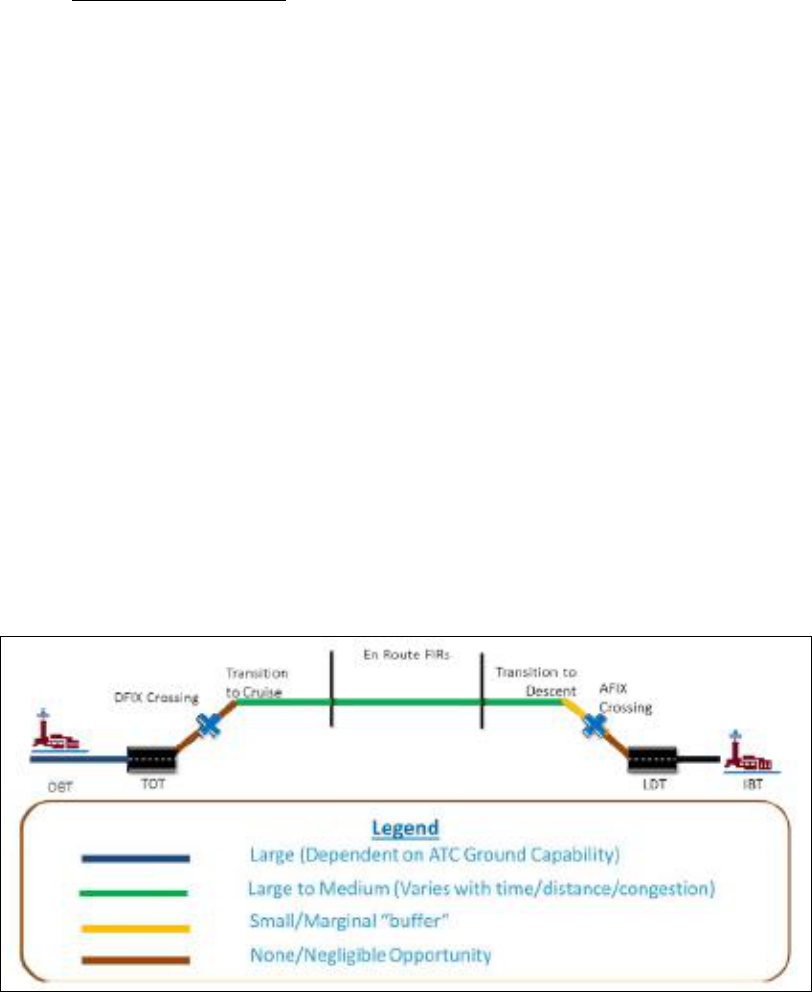
Asia/Pacific Regional ATFM Concept of Operations
4.9 The Regional ATFM concept consequently requires participation from many
departure airports, ANSPs, and airlines to achieve a high level of non-exempt flights. For this reason,
one of the fundamental principles of the Regional ATFM concept is providing Aircraft Operators (i.e.,
airlines) the ability to specify their delay absorption intent between ground delay and airborne flying
time adjustments to achieve their assigned ATFM arrival slot. This overall flexibility is expected to
increase participation by giving long-haul flights the ability to take their delay in the air, where the
delay can be recovered if the program is canceled early. Also, flights that are airborne at the time the
program is implemented will be able to absorb program delay in this concept, further increasing
participation.
Delay Absorption Intent
4.10 One unique aspect of the Regional ATFM concept is that instead of flights being
required to take all of the delay on the ground, Aircraft Operators can choose how to distribute the
delay assigned by the TMI throughout various phases of flight. The three delay intent fields are
described below.
Gate Delay Intent: Delay intended to be taken while parked at the gate. By
default, pre-departure flights are assumed to take all program delay at the gate.
Before the flight pushes back, the Aircraft Operator has the ability to move all or
a portion of the delay to the Airport Surface Delay Intent and/or the Airborne
Delay Intent.
Airport Surface Delay Intent: Delay intended to be taken between pushback
and takeoff. This allows for flights to plan taking additional ground delay in
cases where the airport or ATC requires the parking stand to be vacated prior to
the absorption of all intended ground delay.
Airborne Delay Intent: Delay intended to be taken efficiently during the cruise
portion of flight. For flights that are airborne or will soon be airborne when the
TMI is implemented, all of the program delay is assigned to the Airborne Delay
Intent. The ability to absorb program delay in the air is not part of any current
operational ATFM system.
4.11 Figure 2 illustrates the opportunity for absorbing delay in various phases of flight.
Figure 2: Opportunity for Absorption of Delay per Phase of Flight
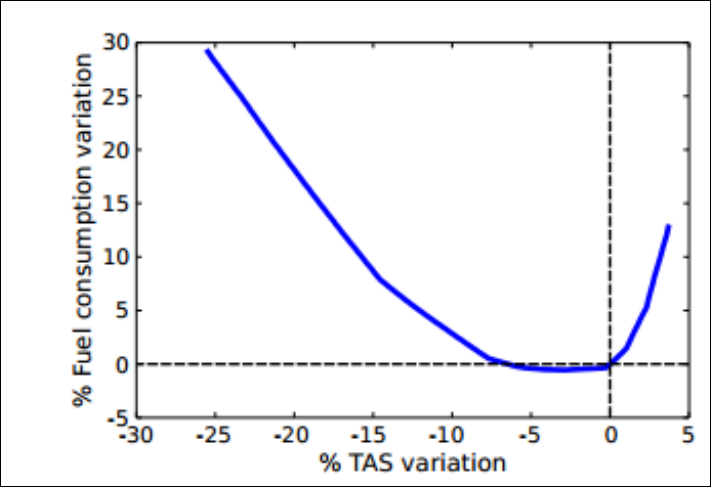
Asia/Pacific Regional ATFM Concept of Operations
4.12 Permitting flights to absorb ATFM program delay in the air can increase the number
of flights participating in the program. In current ATFM systems GDPs generally exempt longer
distance flights (e.g., flights traveling more than 2000 NM) due to risk of such flights taking
unrecoverable delay; these flights could absorb delay on the ground, depart, and then the constraint at
the arrival airport does not materialize, meaning that the flight absorbed delay unnecessarily.
4.13 Under the Regional ATFM concept these longer flights can fly at a slower speed
without any increase in fuel burn. For example, one study has shown that a flight between Rome and
Paris can decrease its cruise speed by about 6% without changing altitude or fuel burn (Figure 3). The
risks of long haul flights either taking unrecoverable delay or not participating in the ATFM program
are decreased.
Figure 3: Fuel consumption variation for A320 Rome-Paris, F320, Mach 0.78,
Cost Index 25 [Muñoz 2013]
4.14 Aircraft Operators may notify their delay intent by using one of two methods:
via a web-based interface; or
via a new flight plan or flight plan amendment.
4.15 When using the web interface, the Aircraft Operator directly enters the delay intent
fields demonstrated in Figure 4. The aircraft operator may apportion some or all of the total delay to
any of the three fields.
4.16 If the flight plan method is used the ATFM system infers the Intended Gate Delay
and Intended Airborne Delay based on the filed Estimated Off-Block Time (EOBT) and filed
Estimated Elapsed Time (EET) extracted from the new or amended flight plan.
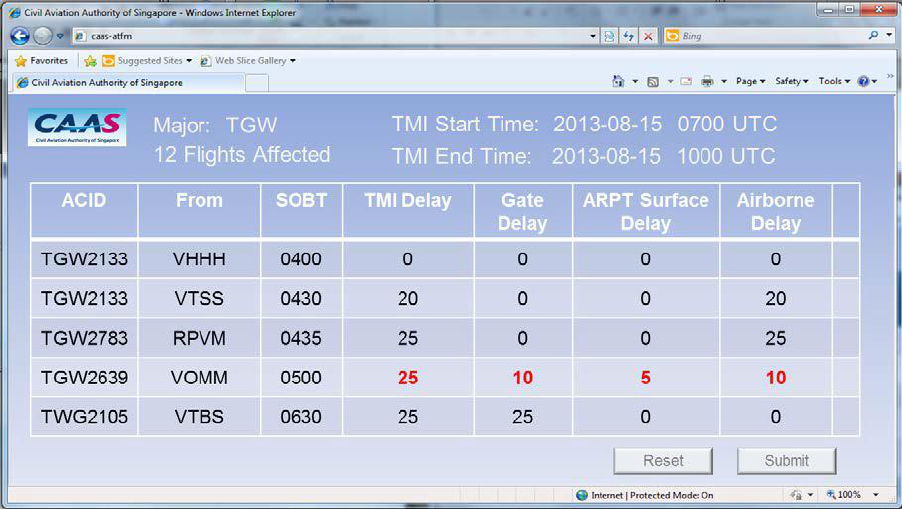
Asia/Pacific Regional ATFM Concept of Operations
Figure 4: Example of web-based interface for delay absorption intent.
4.17 If the flight plan method is used to submit delay intent, en-route ATC will be aware
of the flight-planned cruise speed and will control the flight appropriately. Flights that specify
airborne intent via the web interface are expected to communicate their intended cruise speed to en
route ATC as a request per current ATC procedures. ATC will continue to control the flight as done in
current operations but may assist the pilot in meeting their intended airborne delay. This approach
minimizes the required training and involvement of en-route ATC for deployment of this Regional
ATFM concept. Involvement of en-route ATC is a future consideration for the concept.
4.18 Since many of the major airports in the APAC region are IATA level 3 Slot
Controlled Airports, much of the work to balance demand and capacity in the strategic ATFM phase
is already taking place. This process requires a rigorous analysis of the airport operations in order to
determine the capacity of the airport. The scheduled demand is usually coordinated during bi-annual
IATA Slot Conferences.
4.19 Airport Strategic Slot information is used by the ATFM process to transition from the
strategic plan to the pre-tactical plan, then to the tactical plan on the day of operations. The flight data
from the Strategic Slots is loaded in the ATFM System by the Aircraft Operators or ANSP at least one
day prior to the day of operations. Figure 5 shows a sample of the type of demand graph that should
be available to the relevant stakeholders to easily identify periods of demand-capacity imbalances and
decide whether or not an initiative must be implemented.
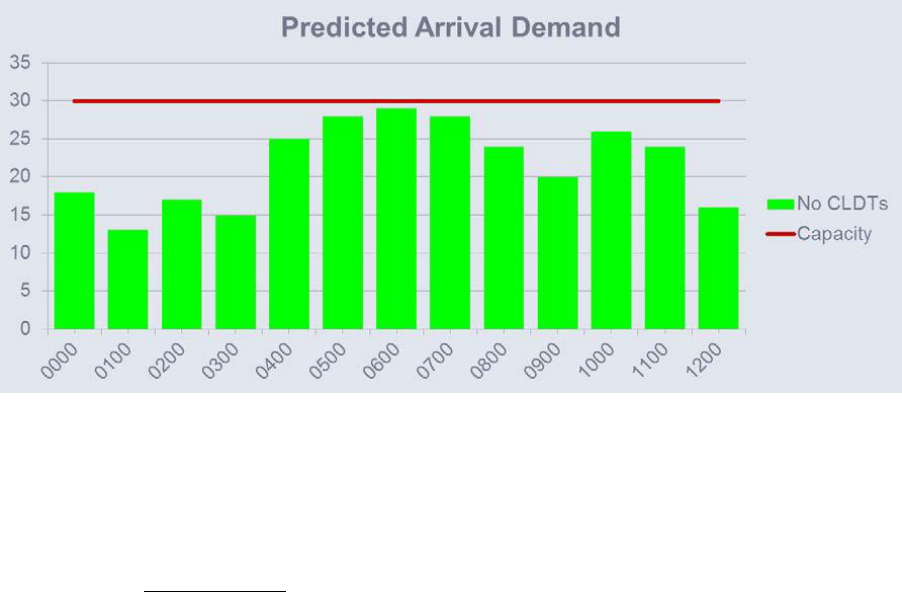
Asia/Pacific Regional ATFM Concept of Operations
Figure 5: Example of capacity and demand
4.20 The stated capacity may change throughout the day due to operational factors or
forecast weather. Capacity rates can be loaded into the ATFM system to reflect the capacity during a
certain time period. For example, runway configuration changes could vary the rates in a predictable
manner.
Initiating a TMI
4.21 The Flow Management Position (FMP) continuously monitors the demand and
capacity. When the current or predicted demand exceeds the capacity, the FMP will determine
whether or not an ATFM program is needed based on the severity of the demand-capacity imbalance
as well as feedback from CDM stakeholders. Prior to implementing TMIs under an ATFM program,
the FMP and CDM stakeholders will have the ability to model with different parameters, including:
TMI start and end time
- Flights with estimated landing times within the start and end time of the
program will receive ATFM slots
- Non-exempt and exempt flight criteria
Exemption criteria by: airline, airport, distance from arrival airport, or flight
- Airborne Exemption Horizon: Flights that are airborne when the program is
initiated and expected to land within the Airborne Exemption Horizon are
exempt from the program
Airport Acceptance Rate (AAR)
- Number of aircraft that can land at the airport in a given time bin based on the
predicted conditions

Asia/Pacific Regional ATFM Concept of Operations
Required Notification Time
- When a TMI is run, pre departure flights that are expected to depart sooner
than the Required Notification Time will have a default delay intent to absorb
all of their delay in the air
4.22 The FMP will evaluate if the demand is sufficiently smoothed and also consider the
average delay, maximum delay, and number of affected flights to determine the impact of the ATFM
program. Once the optimal parameters are set, the FMP runs the program and slot times are sent to
Aircraft Operators, air traffic control towers, and other stakeholders.
Maximum Delay
4.23 Included in the concept it is the acknowledgement that certain flights will have a
limited amount of delay that can be absorbed. For example, an active flight cannot absorb any delay
on the ground and will only be able to efficiently absorb a limited amount of delay in the air based on
remaining flying time. Also, flights may have a limited amount of delay they can absorb on the
ground due to constraints of the departure airport. For example, if some airports have very high gate
utilization and very few holding areas, the amount of ground delay for a flight will be limited.
4.24 To address this, the concept includes a component termed Maximum Delay.
Maximum Delay is made up of three parameters: Maximum Gate Hold, Maximum Surface Hold, and
Maximum Airborne Adjustment. The Maximum Gate Hold can be provided by the associated
departure Airport Operator and the Maximum Surface Hold can be provided by the departure tower.
Both of these parameters can be set by time frame and by departure terminal. The Maximum Airborne
Adjustment is estimated by the ATFM system considering the distance between the departure and
arrival airports or remaining flying time for airborne flights.
4.25 The use of the Maximum Delay concept can be tailored for implementation based on
the needs of individual ANSPs. The considerations for the use of Maximum Delay are presented in
paragraphs 4.76 and 4.77.
Collaborative Decision-Making
4.26 A key benefit of the Regional ATFM concept is an increase in collaboration that must
take place in order to have an efficient and effective Regional ATFM concept. Through the ATFM
System, stakeholders will be given a broader view of system constraints that might affect their
operation with enough lead time to create a plan of action. This increased situational awareness will
facilitate stakeholder collaboration in deciding a course of action.
4.27 Aircraft Operators are given the flexibility to manage their allocated ATFM delays in
order to best meet their business objectives. Aircraft Operators will have the capability to substitute
slots between any two flights that they operate. This can be done to reduce the delay of a high priority
flight or move a delayed flight (e.g., mechanical delay, crew delay, or delay from a prior flight
segment) into a slot that it can meet.
4.28 Aircraft Operators also have the ability to substitute flights into a later slot even if
they don’t have another flight that they operate to swap into the earlier slot. This is called an Inter-
operator Slot Exchange. The flight requesting a later slot submits the earliest time that it can operate
and the system automatically selects one or more flights to move forward. Notifications are then sent
to the Aircraft Operators that have flights which had their delay reduced, known as bridged flights.

Asia/Pacific Regional ATFM Concept of Operations
Compliance
4.29 Non-exempt flights will be measured for compliance based on their allocated slot
times versus actual time of operation. Medium and long range flights which have the ability to absorb
some delay in the air are measured for compliance with reference to the calculated time over (CTO)
an arrival fix (AFIX). Short haul flights that do not have the ability to efficiently absorb a significant
amount of delay in the air may instead be measured for compliance with either their actual off-block
time (AOBT) or actual take-off time (ATOT).
4.30 For ATFM measures relating to airspace demand and capacity balancing, compliance
may be measured against the CTO at an en-route fix (RFIX).
4.31 Compliance is measured at a fix rather than at landing as flights have more control
over meeting a fix crossing time prior to initiated tactical ATC sequencing into the arrival airport.
ANSPs specify the fixes that are to be used both for TMIs and measuring compliance. Flights will
attempt to arrive at this fix within a compliance window.
4.32 Exempt flights are not considered for compliance measurement. These exempt flights
are determined by the FMP for a given program and could include flights outside a given radius,
flights departing from certain airports, and special case flights, for example very-very important
person (VVIP) flights. These flights will be assigned a slot time, which may involve some delay, but
the flights will not be expected to comply with their assigned delay.
4.33 Additionally, flights will be filtered from compliance consideration in cases where
the Aircraft Operator is not at fault. For example, if the pilot does everything in their control to meet
assigned slot times yet the flight arrives early or late due to an ATC constraint, then the flight will not
be considered non-compliant.
4.34 ANSPs have flexibility to develop their own policy and procedures for the handling
of non-compliant flights. The considerations for the alternatives are explained in paragraphs 4.71 to
4.75.
4.35 Measuring and sharing of compliance statistics must be part of every implementation
of the Regional ATFM concept.
Post-Operations Analysis
4.36 A key component of the ATFM system as a data-sharing platform is the analysis
capability enabled to study the effectiveness of ATFM programs and TMIs, and to establish trends
over time. Post-operational analysis is indispensable for the FMPs to improve the parameters in the
TMIs to achieve the desired outcome. The results of these analyses can be shared among FMPs in the
region and “best practices” can be established.
4.37 The metrics used for post operations analysis are listed in the tables below. Table 1
lists the general scenario metrics, which are used to measure the severity of events that occurred, the
TMI parameters selected to resolve the issues, and the impact of the TMI on stakeholders during a
given time period. Table 2 lists the CDM action metrics, which are used to determine how active the
Aircraft Operators were in managing their flights.

Asia/Pacific Regional ATFM Concept of Operations
Metric
Description
Type
Number of Flights
The total number of flights that received
calculated times
TMI
Parameter
Start/Stop Time
The Start and End time of the TMI. The
time period when the FMP wanted to
control the demand
TMI
Parameter
Lead Time
The number of minutes the TMI was
implemented before the Start Time
TMI
Parameter
Number of Exempt/
Non-Exempt flights
The number of flights that were exempt
from the TMI according to the parameters
specified by FMP
TMI
Parameter
Number of TMI
Events
The number of FMP actions that
reassigned flights in the TMI (i.e., number
of revisions and compressions)
Operational
Activity
Total Assigned Delay
The sum of the delay assigned by the TMI
Operational
Impact
Max/Average
Assigned Delay
The maximum and average delay
Operational
Impact
Total
Gate/Surface/Airborne
Delay
The total actual delay taken at the gate, on
the airport surface, and in the air
Operational
Impact
Number of
Cancellations
The number of flights canceled and were
part of a given TMI
Operational
Impact
Number of
Unexpected Flights
The number of flights that appeared after
the TMI was already implemented
Operational
Impact
Table 1: General Scenario Metrics
Metric
Description
Number of
Substitutions
Total number of flights that were substituted
Number of Inter-
Operator Slot
Exchanges
Total number of ISEs
Number of Bridged
Flights
The number of flights that were bridged
Number of
Cancellations
Total number of canceled flights for a given time period
Substitution Savings
The amount of the savings in minutes of flights that move
forward as a result of a substitution
Bridging Savings
The amount of the savings in minutes of flights that move
forward as a result of being bridged
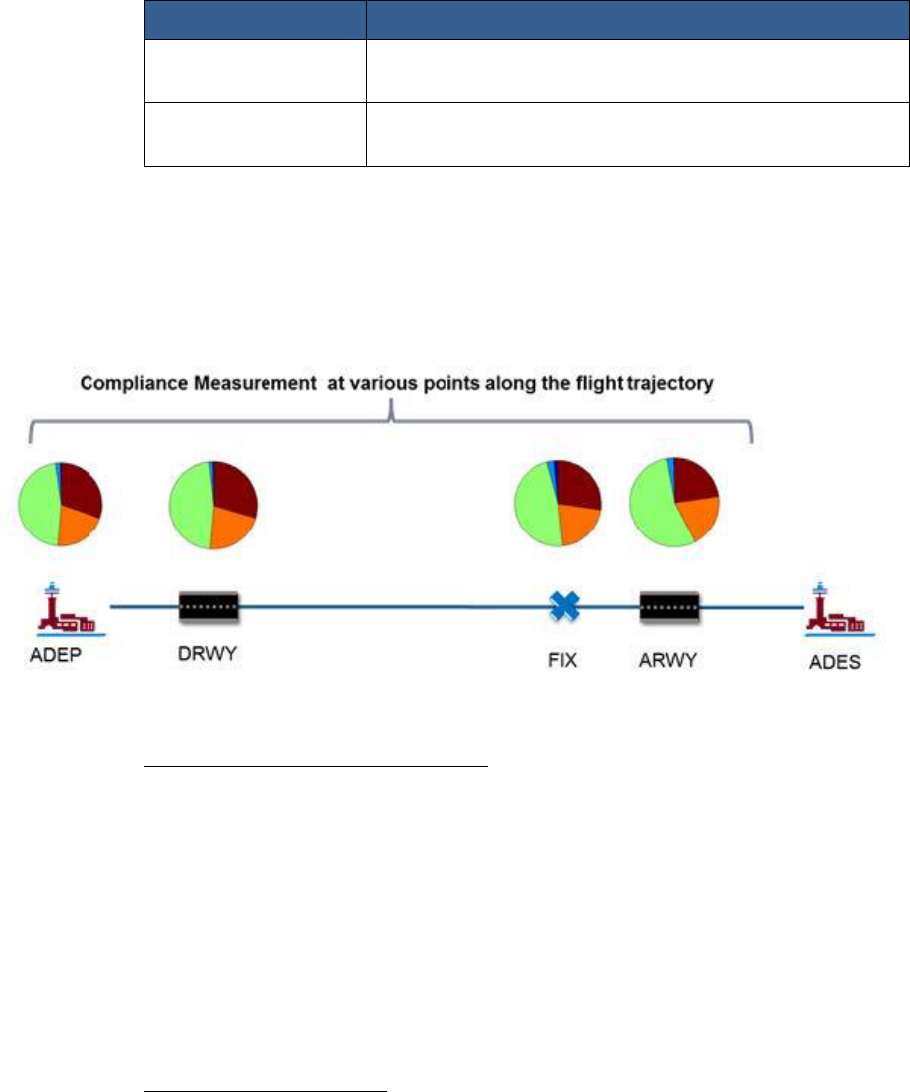
Asia/Pacific Regional ATFM Concept of Operations
Metric
Description
Number of Delay
Modifications
Number of modifications made by the Aircraft Operator to
their flight event times to show flight would be delayed
Number of Delay
Intent Modifications
Number of modifications made by the Aircraft Operator to
their delay intent values
Table 2: CDM Action Metrics
4.38 Compliance metrics are useful for reviewing the effectiveness of a TMI and finding
systemic hindrances on the effectiveness of TMIs. There are many ways that users can view
compliance metrics. For example, in Figure 6 compliance is compared at various points in flight
progress. The different colors in the pie chart show different levels of compliance, where orange and
red are different degrees of late and blue and dark blue are different degrees of early.
Figure 6: Compliance Metrics
Stakeholder Roles and Responsibilities
4.39 With the exception of the FMP, Regional ATFM stakeholders are the same as in the
flight and ATM operations, but with added roles. First of all, stakeholders will collaborate on a daily
basis in order to ensure the smoothest operations. This communication is done by sharing data with
the ATFM System as well as during teleconferences chaired by the FMP. This communication will
lead to a common view of the most accurate demand and resource capacities. When multiple ANSPs
have implemented this concept, the teleconferences may exist at one or more levels of stakeholder
participation to provide the necessary information to all stakeholders in the region.
4.40 In addition to increased communication among the stakeholders, each stakeholder
group has specific changes that result from the concept, described as follows:
Flow Management Position
4.41 Upon implementation of Regional ATFM, an FMP position will need to be
established within each ANSP. FMPs will be part of a new flow management unit that is responsible
for managing the operation of the ATFM system and the associated CDM processes within the ANSP.

Asia/Pacific Regional ATFM Concept of Operations
4.42 The main responsibility of the FMP is to monitor the demand by viewing flight data
from the ATFM System and comparing that to the arrival capacity of the airport(s) in their
jurisdiction. The FMP collaborates with relevant stakeholders to update the capacity (i.e., AAR) when
there is a constraint such as predicted weather or resource maintenance/outage. Whenever the
predicted demand exceeds the capacity, the FMP must determine the best solution for the problem,
which will likely involve implementing a TMI. The FMP will have the ability to model various
initiatives to smooth the imbalance and, in coordination with local stakeholders, select the solution
that causes the least operational impact. Additionally, if multiple ANSPs in the region have an ATFM
system, the FMP may coordinate with FMPs of other ANSPs to establish the best regional solution
taking all the regional requirements into consideration. While ANSPs may have different ATFM
systems, they will transmit and receive data in a common way, thereby enabling all regional FMPs to
share the same operational information.
4.43 Once the ATFM program is run, the FMP will monitor the performance of the
program. The FMP has the ability to revise a program if any of the parameters need to be changed.
The FMP also has the ability to perform a compression (optimizing slot allocation) on a program to
reassign flights to slots and to fill in any empty slots. Both of these actions involve having new slot
times assigned and sent to the Aircraft Operators; therefore, these FMP actions are limited to
operational need based on updated flight data or capacity information.
4.44 The FMP will also be responsible for chairing scheduled and ad hoc teleconferences.
Scheduled teleconferences will likely be held daily in the morning and afternoon. The daily airspace
plan will be discussed and could include: demand anticipated during the day, weather forecasts and
constraints, resource availability/non-availability, special use of airspace, Aircraft Operator
operations, proposed TMI modeling and implementation, and post-event analysis. Ad hoc
teleconferences can also be held should circumstances dictate a need.
Aircraft Operators
4.45 Aircraft Operators will see changes in the way they manage their flights due to the
redistribution of inevitable delay. When a demand and capacity imbalance is predicted, an ATFM
program will shift the delay from the more costly airborne holding delay to the more efficient ground
delay or airborne adjustment. Both the Flight Operations Center (FOC) and pilot need to be aware of
the assigned TMI and work to comply with it in order for the concept to be effective and equitable.
4.46 An additional role of the Aircraft Operator is to provide the demand inputs into the
ATFM System in the pre-tactical and tactical time frame. These data could include flight schedule
uploads and flight plans. As the time to operate the flight approaches, the Aircraft Operator can
update flights’ EOBT (e.g., flights delayed due to mechanical issue) through the ATFM System,
making the changes visible to all stakeholders.
Note: Delay information input to the ATFM system does not replace the aircraft
operator or pilot-in-command obligation to file delay, amendment, or cancellation
and new FPL information, as specified in ICAO Doc 4444 PANS-ATM and State AIP.
4.47 When an ATFM program is implemented, Aircraft Operators have the flexibility to
prioritize flights within the pool of slots they have been assigned and to specify the intended delay
distribution for their flights. The FOC will communicate this delay intent to pilots and the flights will
be measured for compliance with the slot times, as described in paragraphs 4.71 to 4.75.

Asia/Pacific Regional ATFM Concept of Operations
Airport Operators – Departure Airports
4.48 Airport Operators will be impacted by implementation of a TMI as a departure flight
may elect to take ground delay at the gate or between pushback and departure, which affects gate
allocations and movement area and apron and taxiway usage. The Airport Operators’ main
involvement in the regional concept is to coordinate with Aircraft Operators for absorbing delay on
the ground whenever necessary.
4.49 Where airport terminal (gate) capacity is constrained Airport Operators may submit
Maximum Gate Delay values to the ATFM system, as described in paragraphs 4.24 to 4.26.
Airport Operators – Arrival Airports
4.50 Airport Operators will be responsible for advising the FMP on capacity constraints
predicted at the airport. They will be expected to participate in scheduled and ad hoc teleconferences.
The Airport Operator will advise the FMP should the TMI have an adverse effect on operations at the
monitored airport.
Airport Collaborative Decision Making (A-CDM) Interface
4.51 A-CDM systems should interface with the ATFM system, using the Regionally
agreed terminologies relevant to both ATFM and A-CDM; CTOT and calculated landing time
(CLDT).
ATC – Departure Tower
4.52 The Tower ATC can facilitate compliance with ground delay intent as far as
operational constraints allow. With access to the flight-specific intended takeoff time, Tower ATC
staff can assist flights to have a compliant departure.
4.53 In addition, the Departure ATC Tower can coordinate where to best place the flights
if the aircraft are to be held on the movement area in order to absorb the ground portion of the delay.
4.54 Lastly, the Tower can submit Maximum Surface Delay values to the ATFM system,
as described in paragraphs 4.24 to 4.26. The ATFM system should flag Maximum Surface Delay
values input by ATC to identify where ATC or airport surface capacity constraint results in non-
compliance with a TMI.
ATC – Arrival Tower
4.55 The ATC Tower supervisor will be required to keep the FMP advised of constraining
events at the airport. The Tower supervisor will be required to participate in teleconferences so as to
add to the pre-tactical and tactical CDM processes. In addition the tower supervisor will be required to
tactically determine the AAR and advise the FMP if any change in the AAR is required.
ATC – Area Control Centre (ACC)
4.56 En-route ATC units and centres will have no requirement to change their operational
procedures to accommodate flights subject to a TMI. Pilots may request an altitude or speed change in
order to comply with their delay intent distribution. The ATC will follow normal ATC operating
procedures before approving these changes. Education on the fundamental principles of the Regional
ATFM concept will serve to increase controllers’ awareness.

Asia/Pacific Regional ATFM Concept of Operations
4.57 Terminal Area (TMA) ATC unites in certain implementations of ATFM may have
the authority to de-prioritize non-compliant flights. This model can be adopted but requires
compliance status of flights being available to ATC. Adding this function to the terminal ATC
depends on the ANSP’s decision made in terms of compliance handling described in paragraphs 4.71
to 4.75.
Proposed Changes Resulting from Implementation
4.58 The following Technology and Policy changes supporting the implementation of the
Regional ATFM Concept are proposed.
Technology Changes
4.59 Stakeholders will able to perform demand and capacity balancing during the pre-
tactical and tactical phases with the ATFM system. Through this system the FMP can model ATFM
programs with various parameter values to optimize the solution. When the TMI is acceptable to the
FMP, the TMI is run and the slot times are automatically calculated and sent to the appropriate
Aircraft Operators.
4.60 Common situational awareness for all the stakeholders is essential for implementing
effective TMIs; the ATFM system will bring this situational awareness to ANSPs, Aircraft Operators,
Airport Operators, and other stakeholders. The ATFM system will integrate various data sources with
the most accurate and up-to-date operational information. Users can connect to the ATFM system to
view pertinent information as well as update any changes to their operations. Efficient sharing of
more accurate data leads to better decision making in a timely manner. A CDM platform is required
where Aircraft Operators are able to carry out advanced CDM processes to optimize schedules.
4.61 Users will be able to access stored data for post-operations analysis. Stakeholders will
be able to view metrics for any previous day of operations (for a list of metrics, refer to paragraph
4.37 Tables 1 and 2). Statistical analysis of post operations data will help identify shortfalls in
operations and methods to improve operations.
Policy Changes
4.62 Policy changes associated with Regional ATFM include involvement in
teleconferences, which will increase information sharing compared with current day operations. CDM
stakeholders may participate in scheduled teleconferences to discuss the plan for the day as well as to
review operations on the previous day. The stakeholders calling into the scheduled teleconferences
include the FMP, Aircraft Operators, neighboring ANSP facilities, the ATC tower(s), and the local
Airport Operator. If necessary, the FMP will coordinate with the FMPs of other regional ANSPs in a
separate teleconference. The FMP may also convene and chair ad hoc teleconferences to handle
unforeseen demand and capacity imbalances.
4.63 Policy in terms of data sharing will have to change with the implementation of
ATFM, since sharing of data is the foundation of CDM. Aircraft Operators will have the ability to
view delay metrics associated with their flights as well as aggregate metrics for all flights. ATC
stakeholders will have unlimited situational awareness with regard to slot assignments. Access,
security, and data integrity must all be addressed in single ATFM System instances and in the
connectivity and data sharing between multiple ATFM System instances.

Asia/Pacific Regional ATFM Concept of Operations
4.64 Aircraft Operators and third-party agencies generally measure on-time performance
(OTP) by comparing flights’ actual off-block times (AOBT) with their scheduled off-block times
(SOBT). With the implementation of ATFM, the policy for measuring OTP should consider flights
impacted by a TMI. For these flights, on-time performance should be determined by comparing
flights’ actual off-block times and actual landing times with their intended off-block times. This is a
challenge for ATFM systems, since Aircraft Operator on-time performance is often defined by
legislative action. To date, the impact of an ATFM initiative on a departure OTP metric has not been
formalized.
Justification for Changes
4.65 Table 3 summarizes the major changes resulting from the Concept, and their
justifications.
Change
Justification
Introduce a Flow
Management Position
A smoother transition of strategic demand and
capacity balancing to pre-tactical and tactical demand
and capacity balancing
A means of evaluating proposed TMIs in
collaboration with the stakeholders prior to
implementation
A communication position within the ANSP to keep
stakeholders apprised of the operational conditions
Assign slot times to
flights to manage
demand-capacity
imbalances
Reduced fuel burn
Reduced controller workload
Increased predictability of operations
Enhanced safety due to reduced congestion
Aircraft Operators
share flight data with
ATFM system
Accurate and common picture of demand
FMP specifies
capacity
Accurate and common picture of capacity
Aircraft Operators
specify delay
absorption intent
Increased participation improves TMI effectiveness
and results in a more equitable delay assignment
Increased flexibility for Aircraft Operators to manage
flights
Reduced risk of absorbing unrecoverable delay
International and
airborne flights
participate in TMIs
Increased participation improves TMI effectiveness
and results in a more equitable delay assignment
Aircraft Operators
have the ability to
substitute flight slots
Flexibility for Aircraft Operators to manage flights
based on their business models
Airport Operators and
ATC Tower specify
Maximum Ground
Increased situational awareness
- Aircraft Operators: aware of flights which may
have received more delay than they can absorb

Asia/Pacific Regional ATFM Concept of Operations
Change
Justification
Hold
- FMP: more accurate picture of when flights will
actually arrive at the terminal area
Measure compliance
at a fix prior to
landing
Ensure a smooth flow of traffic to the constrained
airport
Move Aircraft Operator compliance point beyond
tactical terminal control area.
Post-Operations
Reporting
Provide a means to discover ways to improve
operations
Teleconferences
Increased situational awareness
Table 3: Changes and their Justifications Arising from the Concept
Impacts During Deployment
4.66 The participation of stakeholders has contributed to the development of the concept
of operations; this participation will need to continue for successful operational deployments. This
participation would include:
Participation in stakeholder meetings establishing business rules specific to an
ANSP’s implementation;
Development of operational procedures;
Training of staff;
Participating in operational daily and ad hoc teleconferences; and
Active participation in data sharing and TMI execution.
Multi-Nodal Concept
4.67 The Regional ATFM concept has been described in the above from the perspective of
a single ANSP. The concept readily applies to multiple ANSPs in the same region all implementing
this form of ATFM/CDM. A key to the concept is that each ANSP would be responsible for
implementing ATFM programs to airports and airspace within their own FIR according to the concept
illustrated in this document. Information sharing between the ATFM systems would allow the users of
any of the systems to have access to network-wide information. This includes Aircraft Operator
access to controlled flights arriving to airports within the areas of responsibility of multiple ANSPs,
and air traffic control tower access to ATFM information on departure flights destined for airspace
and airports within the areas of responsibility of multiple ANSPs with CTOT and CTO reflecting
delay intent from their respective TMIs. Details of the concept and procedures could be customized in
each ANSP based on their individual operational requirements, but it is strongly recommended to
keep the concept as consistent as possible across the region. Refer to paragraphs 4.70 to 4.78 for the
details that can be adapted. Figure 7 provides an example of three networked ATFM nodes under the
Regional ATFM concept.
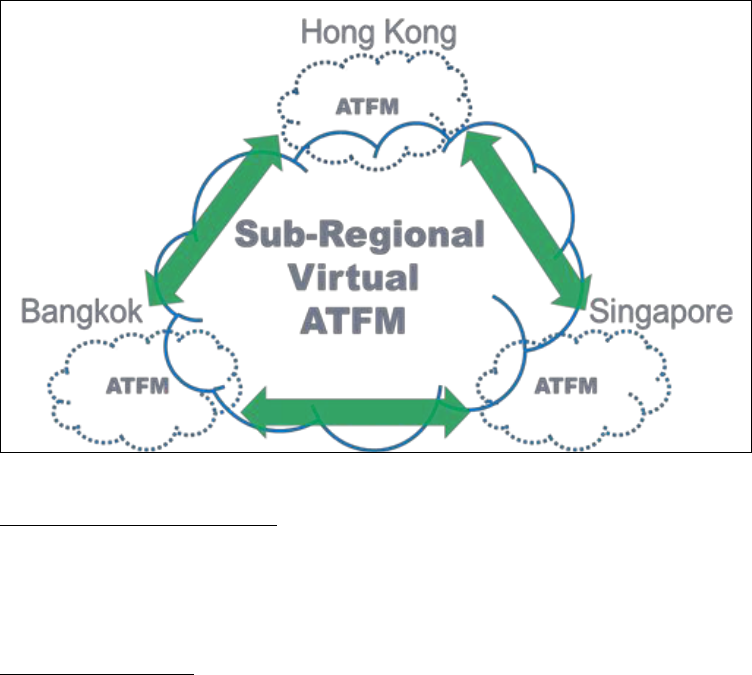
Asia/Pacific Regional ATFM Concept of Operations
Figure 7: Distributed Multi-nodal ATFM Network
Implementation Considerations
4.68 The following concept elements can be addressed to meet the needs of a specific
ANSP. The variations on the elements are described below to provide the full breadth of the concept
without indicating a preference for a specific implementation.
Compliance Handling
4.69 High levels of compliance are critical for TMIs to have a predictable and efficient
flow of traffic. Non-compliant flights could cause bunching in the arrival flow, requiring ATC to
impose airborne holding or other tactical interventions on compliant flights. Non-compliance could
consequently result in loss of trust among Aircraft Operators in the efficiency and equity of the
Concept.
4.70 In current ATFM implementations ANSPs have developed a range of procedures for
preventing non-compliance. The options, together with their advantages and disadvantages, ar: are
presented below along with their advantages and disadvantages. Note that the options are not mutually
exclusive.
Sharing of compliance statistics with stakeholders
- Advantages
Promotes CDM principles through the transparency of data;
Aircraft Operators will strive for high compliance to maintain/improve
the airline’s reputation;
Flights that are unable to absorb delay (e.g. VVIP flights and medical
emergencies) will not be penalized for non-compliance.

Asia/Pacific Regional ATFM Concept of Operations
- Disadvantages
No direct consequences for non-compliance
Departure ATC prevents pushbacks or departures if flights will be non-
compliant with their assigned CTOTs
- Advantages
Little if any non-compliance with CTOTs
- Disadvantages
Increased workload for ground movement controllers
Operational challenges associated with pilots absorbing delay at a
holding pad
No penalty for non-compliance with intended airborne delay
Deprioritize non-compliant flights in the arrival airspace
- Advantages
Equitable amounts of delay taken for compliant and non-compliant
flights
Compliant flights are not penalized when other flights are non-compliant
- Disadvantages
Technical and procedural challenges associated with integrating ATFM
system and AMAN
Increased workload for approach controllers
4.71 Tactically deprioritizing flights in the approach airspace would require the ANSP to
define fixes outside of the approach area that would be used to measure the compliance. If the ANSP
has an AMAN, it would be best to measure compliance prior to the AMAN handoff point. This would
ensure smooth delivery of the flow into the AMAN, which would then be used to sequence flights to
the runway. It would also provide sufficient time for a Flow Manager or supervisor to decide which
flights to deprioritize if the ANSP decides to deprioritize non-compliant flights. Due to the unique
geometry of the airspaces, the distance from the airport at which compliance is measured will be
adapted to each ANSP.
4.72 The size of the window at which flights are considered compliant is dependent on
implementation and stakeholder involvement. An asymmetric (e.g. -5, +10 minutes) window could be
used because Aircraft Operators have more control over not arriving early than not arriving late. In
other words, Aircraft Operators could be late due to a variety of reasons such as weather deviations or
an ATC constraint. Pilots generally have enough control over the flight to prevent an early arrival.
4.73 Individual ANSPs in the region will set compliance standards within their areas of
responsibility; however, a standard procedure for handling non-compliance is recommended in the
region for operating consistency.
Performance Metrics and Post-Operational Analysis

Asia/Pacific Regional ATFM Concept of Operations
4.74 The metrics for post-operations analysis described in paragraps 4.37 to 4.39 should be
applied to all the ANSPs in the region because they are metrics related to the broader Regional ATFM
concept and not the specific implementations. The common set of metrics will help the international
ATFM community develop a method for comparison with operations around the world. In addition to
those metrics, the concept allows for ANSPs to develop their own metrics and statistics particular to
their operations. Some possible metrics/statistics to consider are:
Program Delivery – Shows how effective the TMI was at balancing the capacity
and demand. It compares the expected demand after the TMI was implemented
with the actual demand. This is useful in identifying periods of non-compliance.
On-Time Performance Metrics – Typically ATFM only considers whether TMIs
were successful in balancing demand with resource capacity. On-Time
performance represents another aspect of national airspace operations that is a
good indicator of efficiency and is directly tied with impacts to the passengers. It
is important to track the impacts to passengers because it gives an insight
whether TMIs were able to give benefits to more passengers rather than more
aircraft.
Environmental Metrics – Shifting air delay to ground delay has a positive impact
on the environment through emissions reduction. Fuel burn metrics could be
developed to study and track positive impacts of implementing a TMI. The
metrics could also support achieving the environmental goals any government
may have.
Additional metrics could delve deeper into airport and airspace operations. They would be useful in
identifying root causes of inefficiencies that have been exposed by higher-level aggregate metrics.
Maximum Delay
4.75 The implementation of the Maximum Delay to flights will be determined by each
ANSP. Three options are:
1. Added as a parameter for the Aircraft Operators to compare to assigned delay
2. Incorporated into FMP demand predictions
3. Maximum Delay is incorporated in slot assignment
4.76 The first use will help Aircraft Operators manage their flights by ensuring the
assigned delay is not greater than the Maximum Delay via delay intent adjustments and substitutions.
The second use will help the FMP determine the effectiveness of a modeled TMI. For example, if
many flights are receiving more delay than their Maximum Delays, the FMP could increase the
participation to reduce the average delay of participating flights. Maximum Delay during slot
assignment could limit the delay assigned to flights such that their assigned delay is less than or equal
to their Maximum Delay. This approach is not recommended for an initial implementation, because it
requires very accurate calculations of Maximum Delay.
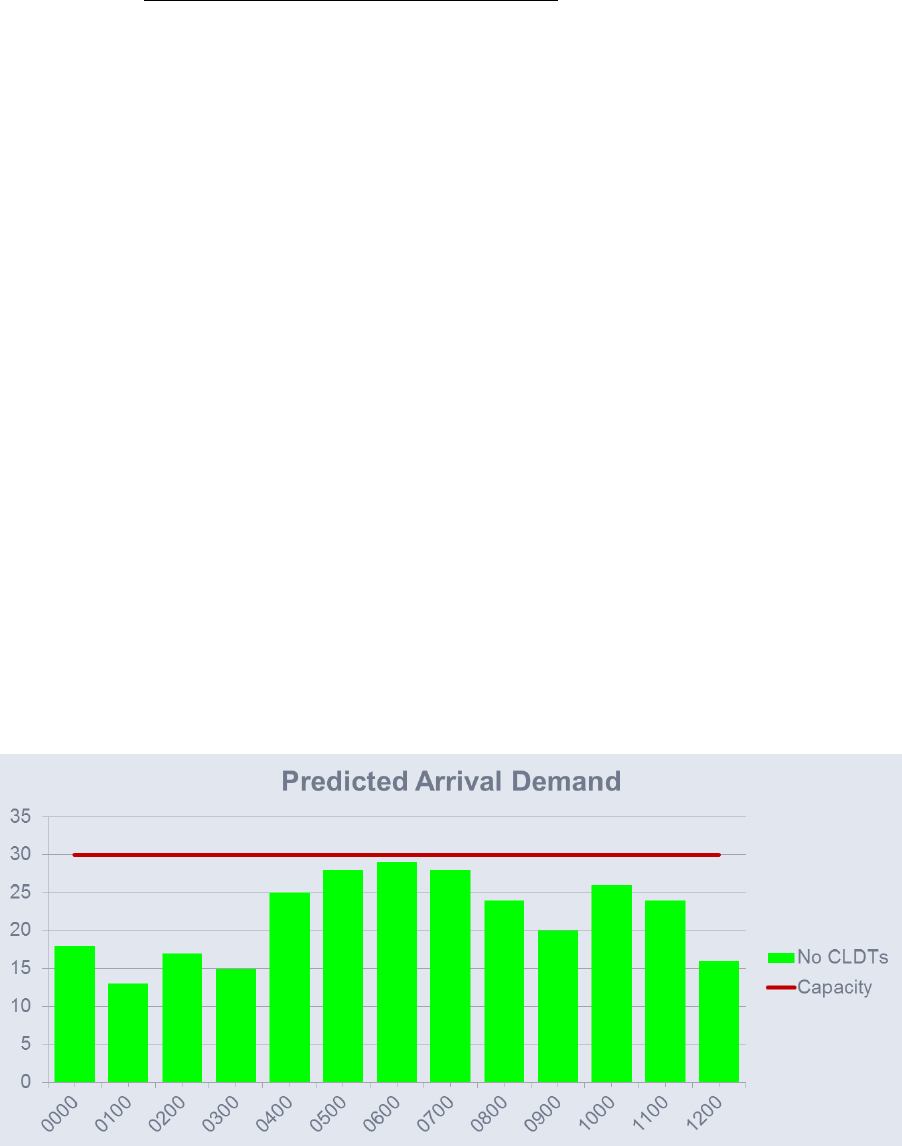
Asia/Pacific Regional ATFM Concept of Operations
Future Considerations – Role of En-route ATC
4.77 Role of En-Route ATC: The Concept of Operations states that the FOC will
communicate delays associated with TMIs to their pilots. If the pilot needs to absorb some delay in
the air in order to be compliant, the pilot will request speed and altitude changes to ATC, and the
controller will approve the request if possible. With this approach, en-route ATC will operate under
the same procedures used currently.
4.78 Increasing the involvement of en-route ATC is possible based on ANSP involvement,
controller training, and the desire to be actively involved in supporting airborne adjustments. For
example, the en-route ATC could be aware of controlled flights’ calculated times and actively direct
flights to ensure compliance. This involvement increases the workload of en-route controllers, but
increases the likelihood that flights are compliant with the ATFM assigned delays. Due to the required
time to add this role and the large number of stakeholders impacted, this role is not considered for the
current concept, but may be considered in the future.
4.79 Additional TMIs: Current implementations of ATFM in the U.S. and in Europe
have additional TMIs such as Ground Stops, Airspace Flow Programs, and Departure GDPs. Ground
Stops were discussed during stakeholder sessions as a means to balance demand and capacity for
capacity reducing events that are predicted with little to no lead time. During Ground Stops, certain
flights are held at their departure airports for a specified amount of time. Ground Stops were not
included in the initial concept of operations because they would be used less frequently than the TMI
described in this document, but may be considered in the future.
5. Operational Scenario
5.1 The initial conditions for this scenario are illustrated in Figure 8. The FMP views the
demand and capacity predictions at the arrival airport. The FMP sets the runway configuration and
AAR after coordinating with the tower and terminal supervisors. The pre-tactical demand is lower
than the nominal capacity, so there is no need for any arrival airport TMIs.
Figure 8: Demand and Capacity Prediction
5.2 At 0000 UTC, the military informs the FMP of a military exercise that will impact the
operations at the airport. The reduced capacity will likely cause a demand and capacity imbalance,
which can be managed by running a TMI. The parameters for the TMI are selected such that the
capacity reducing event will have the least possible impact on all of the stakeholders. The result of the
modeled TMI is shown in Figure 9, with the parameters listed below:
AAR based on the capacity reducing event: 25 between 0500 and 1100 UTC

Asia/Pacific Regional ATFM Concept of Operations
TMI start time: 0500
TMI end time: 1100
- Flights with estimated landing times between the start and time of the
program will receive a slot, or Calculated Landing Time (CLDT), at the
arrival airport.
Non-exempt flights: 15 major airlines from the region
- The major airlines in the Asia Pacific region will attempt to comply with their
assigned slot times, regardless of their departure airport.
- The few remaining flights from other airlines are exempt and will receive
priority in slot assignments.
- Exempt/Non-exempt status can also be set for specific airports and flights
and based on distance.
Active Flight Exemption Horizon: 1 hour
- Airborne flights estimated to land within the next hour will be exempt from
the program and receive priority in slot assignments because they will not be
able to efficiently absorb any delay.
Required Notification Time: 1 hour
- The default intent for pre-departures that are estimated to depart within the
next hour is to absorb all of their delay in the air because the FOCs require
approximately one hour to notify pilots of the TMI.
Figure 9: Modeled ATFM program
5.3 The FMP coordinates with CDM stakeholders via teleconference to coordinate the
potential impact of implementing the TMI. While all stakeholders can provide input on the program
parameters and suggest alternative solutions, the FMP is the ultimate decision maker.
5.4 The FMP runs the proposed TMI and slot assignments are sent to Aircraft Operators.
The slot assignment event times are prefixed with the letter C for Calculated and include:
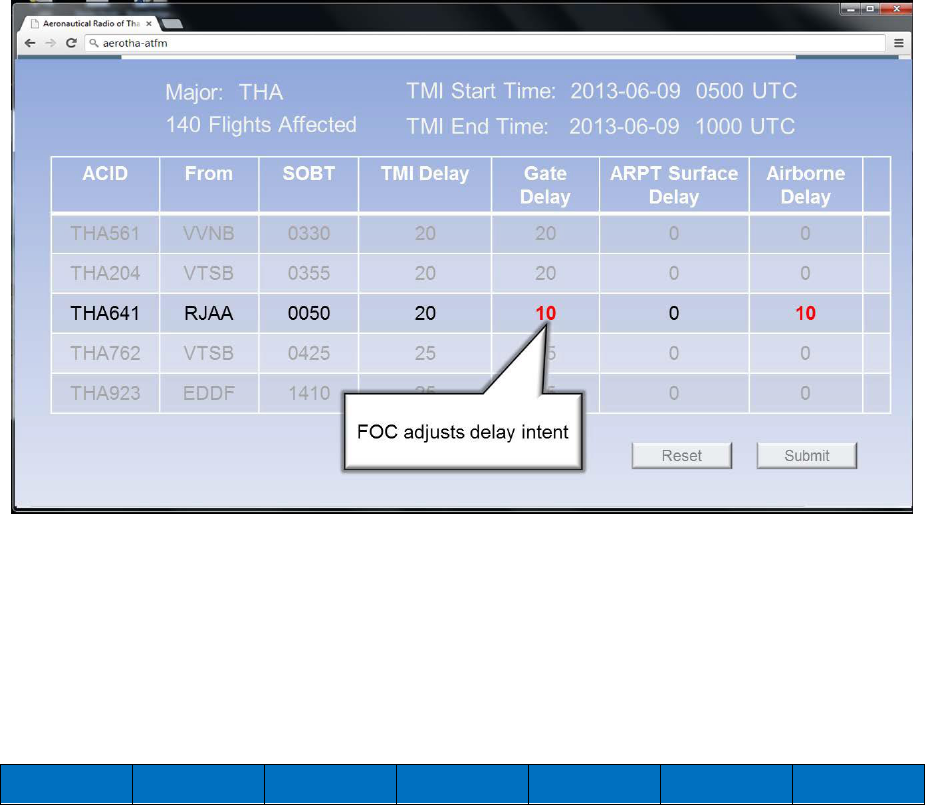
Asia/Pacific Regional ATFM Concept of Operations
Calculated Off-Block Time (COBT)
Calculated Take Off Time (CTOT)
Calculated Over Fix Time (COFT) (used for compliance measurement)
Calculated Landing Time (CLDT) (arrival slot time)
Calculated In Block Time (CIBT)
5.5 Aircraft Operators have the flexibility to distribute the delay intent of pre-departure
flights into three attributes: Intended Gate Delay, Intended Surface Delay, and Intended Airborne
Delay. In certain cases, Aircraft Operators will coordinate gate and surface delay intents with the
Airport Operator to manage gate turnaround times and gate conflicts.
5.6 The Thai Airways FOC decides to absorb a portion of the assigned delay of flight
THA641 in the air (Figure 10). Of the 20 minutes of assigned delay, THA641 intends to absorb 10
minutes at the gate and 10 minutes in the air. The FOC submits the delay intent to the ATFM system
via the web interface. The FOC then informs the pilot of the intended delay.
Figure 10: Delay Absorption Intent
5.7 The event times associated with the intended delay are prefixed with the letters “DL”.
For flights that intend to absorb some delay on the airport surface or the air, their DL Off-Block Time
(DLOBT) and DL Take Off Time (DLTOT) will be different from the Calculated “C” times
associated with the slot. Table 3 shows the updated DL-times for THA641 based on ten minutes of
gate delay and ten minutes of airborne delay. Notice the DLOBT and DLTOT are both ten minutes
earlier than the COBT and CTOT because the flight intends to make up that additional ten minutes
delay in the air.
ACID
DLOBT
COBT
DLTOT
CTOT
DLLDT
CLDT
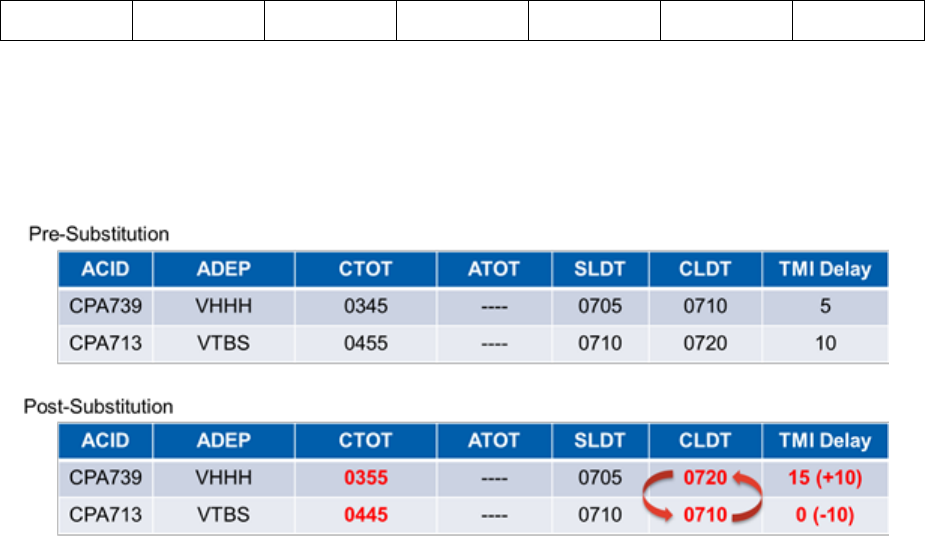
Asia/Pacific Regional ATFM Concept of Operations
THA641
0100
0110
0110
0120
0600
0600
5.8 Aircraft Operators also have the ability to substitute flight slots in order to meet their
business objectives. For example, CPA713 is a high-priority flight, so the Cathay Pacific FOC
substitutes it with CPA739. The CLDTs of the two flights are swapped and the CTOTs are
recalculated based on the new slot times. The result of the substitution is shown in Figure 11.
Figure 11: Pre- and Post- Flight Substitution
5.9 Pilots request pushback clearance at the departure airport at the Delayed Off-Block
Time (DLOBT). Following the departure airport’s procedures, flights receive clearance for pushback.
At certain departure airports, procedures may be altered such that flights can only receive pushback
approval if the request is within a compliance window.
5.10 Approach and en-route controllers will operate as they do in current operations and
may have a basic understanding of the Regional ATFM concept. Flights that intend to absorb some
delay in the air may request speed and or altitude changes en-route in order to meet the intent. The en-
route controller may accept or reject the speed or altitude request based on ATC operational
requirements.
5.11 Arriving flights will be measured for compliance at an AFIX prior to landing. If a
flight’s actual time over (ATO) the fix is within the compliance window of the flight’s CTO for the
fix, the flight will be considered compliant. In addition, flights that are late to the fix due to an ATC
constraint will not be considered non-compliant.
6. Expected Benefits of the Concept
6.1 There are many expected benefits with the implementation of the Regional
ATFM concept. The major areas of improvements upon the current procedures include:
A smoother transition of demand and capacity balancing from strategic to pre-
tactical and tactical phases of ATFM.
Reduced fuel burn and emissions.
Accurate and common view of demand and capacity predictions.
A means of modeling and evaluating proposed TMIs in collaboration with the
stakeholders prior to implementation.
Flexibility for Aircraft Operators to optimize their schedules through a web-
based CDM platform.
Asia/Pacific Regional ATFM Concept of Operations
Flexibility for flights to absorb inevitable delay on the ground or efficiently
through the en route portion of the flight rather than by holding in the terminal
area.
A more reliable data source of stakeholder intent—this applies to Aircraft
Operators sharing how they intend to operate the flights, as well as ANSPs and
airports sharing any resource constraints.
Enhanced safety by ensuring safe traffic densities.
A data platform that integrates various flight data sources and provides common
situational awareness to the stakeholders.
An environment in which TMIs and other operational procedures can be
improved through post-operational trend analysis.
………………………..
Attachment A: ATFM Background
ATFM Initiatives
There are a wide variety of ATFM measures that resolve demand-capacity imbalances by shifting
demand either spatially or temporally. These measures can be classified into the following four groups
[ICAO 2012].
Spacing Restrictions—Require consecutive flights in a common flow to be separated by a
specified time or distance.
- Miles-in-Trail (MIT)
- Minutes-in-Trail (MINIT)
- Minimum Departure Intervals
- En route Sequencing Program
Rerouting—Shifts demand around a weather constraint to create a spatially balanced flow of
traffic.
- Fix balancing
- Collaborative Trajectory Options Diversion of flows
- Level capping (i.e., restricting the altitude of certain flight plans)
- Alternative routings
Ground Holding—Shifts predicted airborne holding delays to ground holding at the departure
airport by controlling flights’ departure times.
- Ground Delay Program (GDP)
- Airspace Flow Program (AFP)
- Ground Stop (GS)
Airborne Holding—In general, airborne holding is more costly than other methods, but Air
Traffic Managers may plan for airborne holding when delays are predicted to be low.
ICAO Guidance on ATFM
The ICAO Manual on Collaborative Air Traffic Flow Management (document 9971 AN/485)
provides recommendations for ATFM implementation. ATFM should be implemented in phases in
order to build stakeholder knowledge as operations become more complex. It is also important for
procedures to be developed in a harmonious manner among states in the region to reduce operational
differences. The ICAO also recommends three communication methods for information sharing:
scheduled telephone or web conferences, tactical telephone conferences, and an automated web
page or ATFM operational information system.
Asia/Pacific Regional ATFM Concept of Operations
The list below is a summary of the ICAO document’s suggested initial steps to implement
ATFM:
Establish objectives, project management plan, and oversight of ATFM
Identify personnel who will lead the development of ATFM
Brief stakeholder groups on ATFM principles
Define the ATFM structure that will be established
Consider the facilities and equipment that will need to be procured
Develop model for establishing AAR
Identify points of contact for dealing with ATFM issues
Define the elements of common situational awareness including: Meteorological
information
Traffic display tools
Identify the appropriate means of ATFM communication
Develop Letters of Agreement between adjacent FIRs
Develop user manuals and training materials
……………………………….
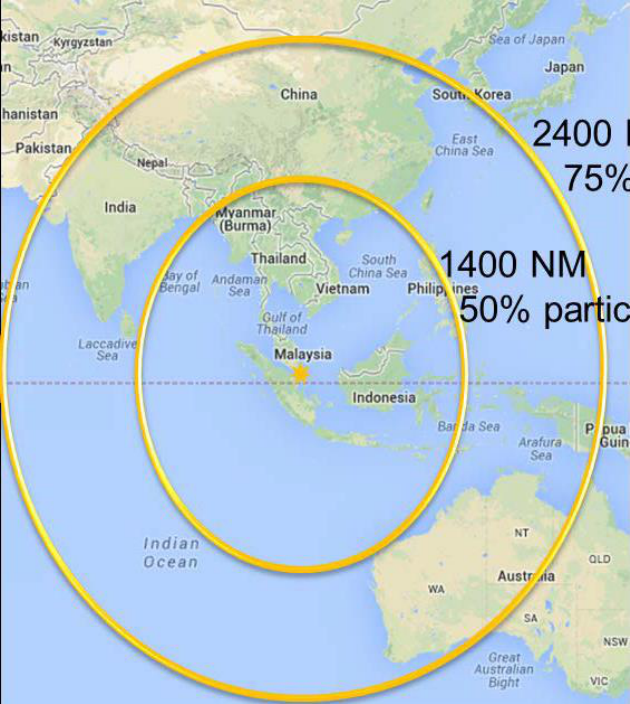
Attachment B: Participation Analysis – Changi Case Study
This following is a summary of an analysis conducted to determine a required participation level
for effective implementation of TMIs.
A fast-time simulation was created to simulate the impact of various participation levels on TMI
effectiveness, using scheduled takeoff times were from Changi arrival data on 3 March, 201. The
flight progress was simulated with GDPs implemented with various reduced capacities at two
participation levels. 1400 NM and 2400 NM radii around Changi provide approximately 50% and
75% participation levels, respectively. The map in Figure B1 shows the airports that are included
in the two radii explored.
Figure B1: Airports within Participation Radius
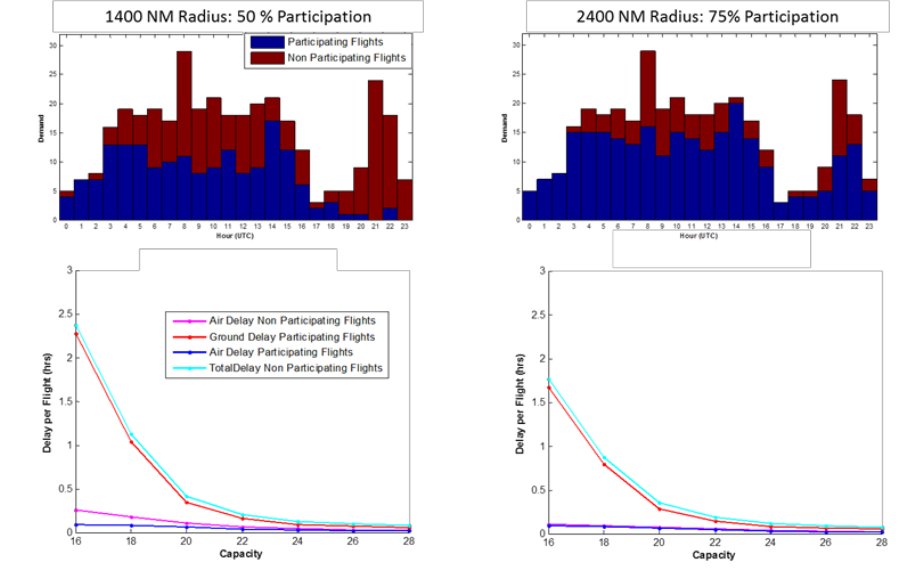
Asia/Pacific Regional ATFM Concept of Operations
The results for the two participation levels are compared in Figure B2. As indicated by the plots,
the total delay increases exponentially as the capacity is reduced. In the severe case of a 16
flights/hour airport capacity (about half of the nominal arrival capacity), participating flights
receive an average of 2.3 hours of delay when participation is 50% and about 1.6 hours of delay
when participation is 75%. Therefore, increasing the participating flights reduces the delay per
participating flight by 0.7 hours. The reason for this reduction is that there are fewer exempt
flights that get priority in the slot assignment.
Figure B2: Participation Analysis
The delays for the non-participating flights are also reduced when the participation level is
increased. In the example below, the airborne delay for non-participating flights is reduced from
0.3 hours to about 0 hours when increasing participation from 50% to 75%. This is because the
demand of participating flights is generally lower than the capacity of 16 when the participation is
75%, whereas when the participation level is 50% there are a significant number of non-
participating flights that need to be delayed in order to bring the total demand below capacity.
When the capacity reduction is less significant, the difference between the two participation
levels is less pronounced. For example, when capacity is reduced to 20, the average delay for
participating flights is reduced from 0.4 hours to 0.3 hours for 50% and 75% participation,
respectively. The reason for this reduction in difference between the two participation levels is
due to the fewer flights that receive delay. As shown in Figure B2, the demand is below 20 for
most of the day, meaning a TMI is not needed for most of the day.
Based on these results and knowledge from currently implemented ATFM systems, high
participation (>75%) is necessary to manage the flow of traffic during events with a relatively
high reduction in capacity. If the capacity reducing event induces minor delays, the flow may be
able to be managed with less than 75% participation.
